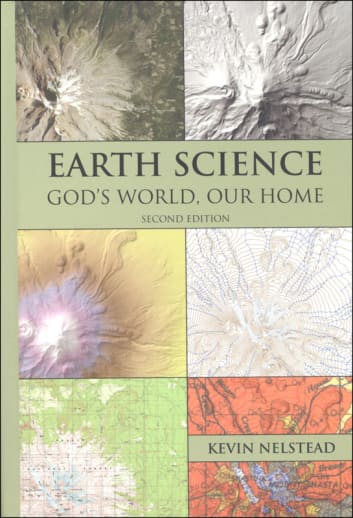Written using a narrative method, Novare’s Earth Science Text is well illustrated with full-color photographs and detailed colorful maps, graphs, and drawings. Topically, students learn about the earth in space, eclipses, the Hebrew, Islamic, and Western calendars, ways to map the earth with a focus on topographical maps, Christianity and earth science, stewardship, matter and minerals, rocks & the rock cycle, plate tectonics, volcanoes & earthquakes, weathering and erosion, hydrological cycle, landforms, unraveling the earth’s history, oceanography, atmosphere, weather, and climate and air pollution. Chapters follow a similar format that include clearly stated objectives and vocabulary, textual readings that are divided into digestible amounts, 'learning checks' at the end of each reading section, and an exercise at the end of each chapter. A glossary, mineral chart, and other resources are found at the back of the text.
Novare Earth Science: God's World, Our Home (2nd Edition)
Product Overview
- Academically rigorous course that uses a mastery approach of teaching fewer topics with more depth than a typical Earth Science course
- Students are taught to see God in creation, while learning current scientific theories that support a modern secular geological timeline
- Core Text used in the Novare Earth Science Program
Description
Earth Science is designed to draw students into close engagement with the subject matter and provide a solid education while fostering a sense of wonder and responsibility for God's amazing world.
Written for middle school-aged students, this book includes all the popular characteristics of Novare textbooks: smaller profile; vibrant, original, and relevant graphics; lucid conversational prose, and an approach that connects students with real-world science as stewards of God's creation.
And of course, Novare's guiding principles of Mastery, Integration, and Kingdom perspective are woven throughout the text. Mastery learning methods are present in the way key concepts, definitions, and skills are repeated. Students rehearse and re-encounter prior concepts as they learn new content with a view toward more thorough retention. We also integrate relevant subjects where possible such as mathematics, history, language skills, measurement and more. This both enhances the reading and demonstrates the connections that exist between all subjects.
Novare's Kingdom Perspective is evident in the attribution of the marvels of creation to God's creative power. Author Kevin Nelstead regularly draws the reader to appreciate the intricacy and excellence of God's works, tying in scripture without becoming heavy-handed.
Earth Science should be about much more than learning about rocks and mountains and the seasons. Think about God's exciting mandate to steward and exhibit vice regency over creation! The best Christian curriculum will bring students into the wonder of God's astounding creation and foster the mind of a gracious and caring steward.
Within the context of the fascinating study of landforms, minerals, and planetary phenomena, many other timely and important topics are covered including conservation of natural resources, climate change, pollution, and environmental justice, as well as the current scientific consensus concerning geologic history.
This text, like our others, includes learning objectives at the beginning of each chapter, Learning Checks along the way to review what has been covered, and exercises at the end of each chapter. There is no teacher's manual, workbook, test book, or separate experiment manual for this text. All supplemental materials are included on the Digital Resources for Earth Science.
Novare Earth Science offers an engaging, well-illustrated earth science course. As students learn earth science concepts and topics, they will be inspired to responsibly care for and protect God’s amazing world. From our solar system to our home planet, students see God’s hand in our creation, as they learn the current scientific consensus on geological history, climate change, pollution, and environmental justice. There is an in-depth study of historical geology which includes differing views on the age of the earth, uranium dating, and the geological column. Students are taught to see God in creation, while learning current secular scientific theories that support an old-earth creation. Students will create lab reports and the introduction to the textbook provides step-by-step guidance. Lab instructions are found in the Digital Resources. An optional Student Lab Report Handbook is available for families who want support. Required components include the Student Textbook and the Digital Resources, which are available individually or in a convenient package. An optional lab kit with most of the harder to find materials is available.
| Product Format: | Hardcover |
|---|---|
| Grades: | 6-8 |
| Brand: | Novare Science and Math |
| Author: | Kevin Nelstead |
| ISBN: | 9780986352911 |
| Length in Inches: | 9.75 |
| Width in Inches: | 6.75 |
| Height in Inches: | 1.1875 |
| Weight in Pounds: | 2.8562 |

